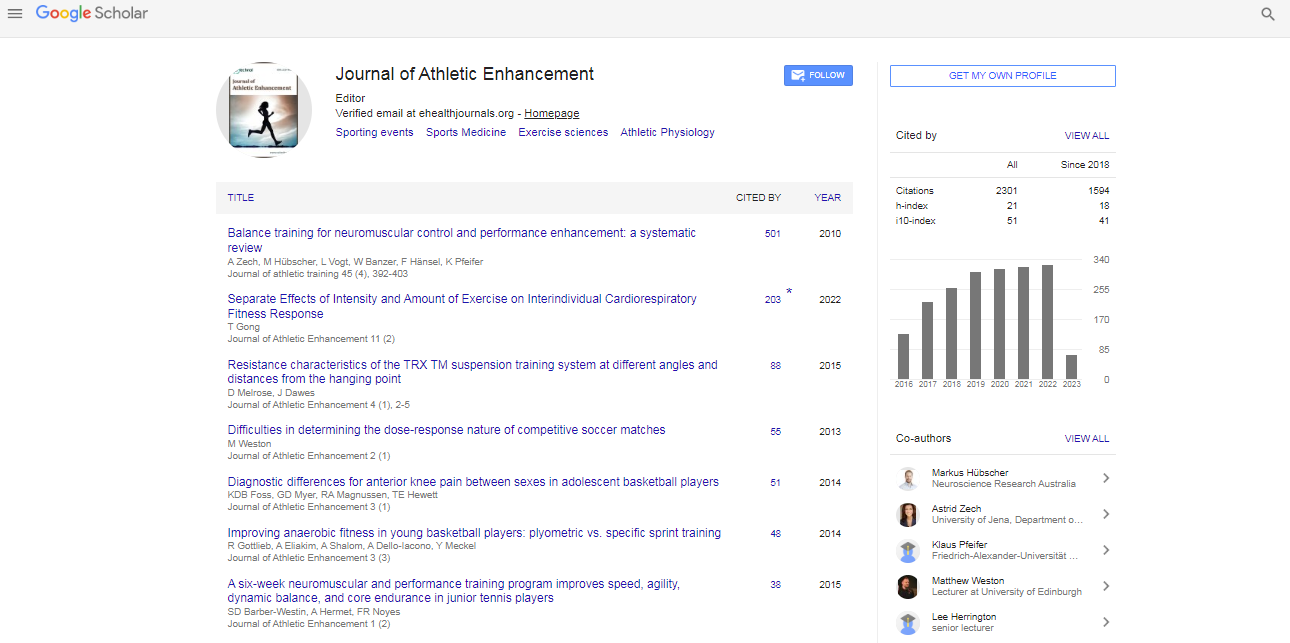Opinion Article, J Athl Enhanc Vol: 13 Issue: 5
Understanding Sport Concussion: Risks, Symptoms, and Management
Zin Wang*
1Department of Physical Education, Dankook University, Gyeonggi-do, South Korea
*Corresponding Author: Zin Wang,
Department of Physical Education, Dankook
University, Gyeonggi-do, South Korea
E-mail: wangzin2024@yeah.net
Received date: 26 August, 2024, Manuscript No. JAE-24-151420;
Editor assigned date: 28 August, 2024, PreQC No. JAE-24-151420 (PQ);
Reviewed date: 11 September, 2024, QC No. JAE-24-151420;
Revised date: 18 September, 2024, Manuscript No. JAE-24-151420 (R);
Published date: 25 September, 2024 DOI: 10.4172/2324-9080.1000149.
Citation: Wang Z, (2024) Understanding Sport Concussion: Risks, Symptoms and Management. J Athl Enhanc 13:5.
Description
Concussions in sports have become a focal point of health discussions, given their potential to cause serious, long-term neurological effects. A concussion is a type of Traumatic Brain Injury (TBI) that occurs when the brain is jolted within the skull, often due to a blow to the head or body. This movement can disrupt normal brain function, leading to a variety of symptoms. While concussions can occur in any sport, contact sports like football, hockey and boxing tend to have higher incidence rates.
Concussions are classified as mild TBIs; however, their effects can be profound and lasting. The injury occurs when the brain is subjected to a sudden acceleration or deceleration, causing it to hit the interior of the skull. This can lead to chemical changes in the brain and damage to brain cells. Although most people recover fully from a concussion, some individuals experience prolonged symptoms that can significantly impact their quality of life.
Common symptoms
Symptoms of a concussion can vary widely and may not appear immediately. They can be physical, cognitive, emotional, or sleeprelated.
Physical symptoms: Headache, dizziness, balance problems, nausea and sensitivity to light or noise.
Cognitive symptoms: Confusion, difficulty concentrating and memory problems.
Emotional symptoms: Irritability, sadness, increased emotional responses.
Sleep disturbances: Trouble falling asleep, sleeping more than usual, or insomnia.
It's important to recognize that symptoms can evolve over time. Athletes may initially appear fine but can develop symptoms hours or days after the injury.
Diagnosis and assessment
Accurate diagnosis of a concussion is important for proper management. Medical professionals typically use a combination of neurological examinations, cognitive tests and symptom checklists to assess an athlete's condition. One widely used tool is the Sport Concussion Assessment Tool (SCAT), which helps to evaluate symptoms, cognitive function and balance.
In some cases, imaging studies like Computed Tomography (CT) or Magnetic Resonance Imaging (MRI) scans may be employed to rule out more severe injuries, such as brain hemorrhages. However, it is essential to note that concussions often do not show up on these scans, making clinical assessment vital.
Prevention strategies
Preventing concussions in sports is an ongoing challenge. While complete avoidance may not be feasible, several strategies can help reduce the risk.
Education: Athletes, coaches and parents should be educated about the signs and symptoms of concussions and the importance of reporting injuries.
Protective equipment: Properly fitted helmets and other protective gear can reduce the risk of head injuries. However, it’s important to note that no equipment can prevent concussions entirely.
Rule modifications: Many sports are implementing rule changes to minimize risky behaviors, such as targeting in football or body checking in youth hockey.
Safe playing environments: Ensuring that playing surfaces are well-maintained and that games are officiated by knowledgeable referees can also help reduce risks.
Concussions are a significant concern in the world of sports, necessitating a comprehensive approach to management and prevention. By increasing awareness, improving education and implementing preventive measures, stakeholders can help safeguard the health of athletes. Prompt recognition and proper management of concussions are vital to ensuring athletes can safely return to their sport and minimize the risk of long-term neurological damage.
 Spanish
Spanish  Chinese
Chinese  Russian
Russian  German
German  French
French  Japanese
Japanese  Portuguese
Portuguese  Hindi
Hindi 
